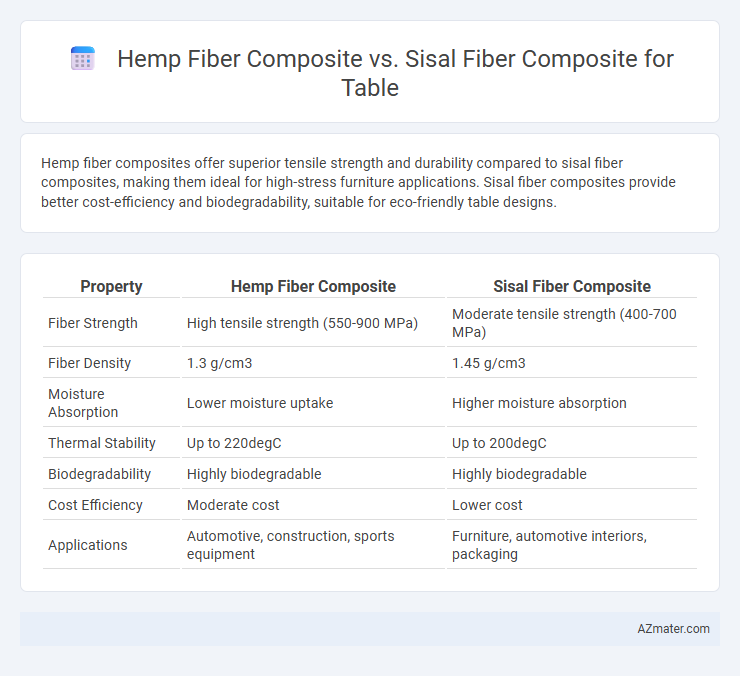Hemp fiber composites offer superior tensile strength and durability compared to sisal fiber composites, making them ideal for high-stress furniture applications. Sisal fiber composites provide better cost-efficiency and biodegradability, suitable for eco-friendly table designs.
Table of Comparison
| Property | Hemp Fiber Composite | Sisal Fiber Composite |
|---|---|---|
| Fiber Strength | High tensile strength (550-900 MPa) | Moderate tensile strength (400-700 MPa) |
| Fiber Density | 1.3 g/cm3 | 1.45 g/cm3 |
| Moisture Absorption | Lower moisture uptake | Higher moisture absorption |
| Thermal Stability | Up to 220degC | Up to 200degC |
| Biodegradability | Highly biodegradable | Highly biodegradable |
| Cost Efficiency | Moderate cost | Lower cost |
| Applications | Automotive, construction, sports equipment | Furniture, automotive interiors, packaging |
Overview: Hemp Fiber Composite vs Sisal Fiber Composite for Tables
Hemp fiber composites offer higher tensile strength and better durability compared to sisal fiber composites, making them ideal for sturdy table construction. Sisal fiber composites provide natural resistance to moisture and cost-effective production but typically exhibit lower mechanical performance. Both materials are eco-friendly alternatives to synthetic fibers, with hemp composites favored for load-bearing applications in furniture manufacturing.
Material Properties: Hemp vs Sisal Fibers
Hemp fiber composites exhibit higher tensile strength and superior durability compared to sisal fiber composites, making them more suitable for long-lasting table applications. Hemp fibers also show better moisture resistance and dimensional stability, enhancing the table's resistance to warping and degradation. Conversely, sisal fibers are more affordable but tend to absorb more moisture, reducing the overall structural integrity of the composite in humid conditions.
Sustainability and Environmental Impact
Hemp fiber composites exhibit higher sustainability due to their rapid growth cycle, low pesticide requirement, and superior carbon sequestration compared to sisal fiber composites, which rely on more intensive water usage and slower renewal rates. The biodegradability of hemp composites significantly reduces long-term environmental waste, while sisal composites, though natural, tend to have a higher environmental footprint due to soil depletion and energy-intensive processing. Life cycle assessments show hemp fiber composites outperform sisal in reducing greenhouse gas emissions and promoting eco-friendly production for sustainable table manufacturing.
Mechanical Strength and Durability Comparison
Hemp fiber composites exhibit higher tensile strength and impact resistance compared to sisal fiber composites, making them more suitable for heavy-use tables. Hemp fibers provide enhanced durability due to their superior fiber-matrix adhesion and resistance to environmental degradation. Sisal fiber composites, while cost-effective and eco-friendly, generally show lower mechanical strength and faster wear under mechanical stress.
Moisture Resistance and Dimensional Stability
Hemp fiber composites exhibit superior moisture resistance compared to sisal fiber composites due to their lower water absorption rate, contributing to enhanced durability in humid environments. The dimensional stability of hemp fiber composites outperforms sisal fiber composites, reducing the risk of warping or swelling when exposed to fluctuating moisture levels. These properties make hemp fiber composites a preferable choice for furniture like tables, where long-term structural integrity and stability are critical.
Aesthetic Qualities and Surface Finish
Hemp fiber composites exhibit a smooth, fine texture with a natural matte finish, enhancing the aesthetic appeal of tables through subtle variations in fiber patterns. Sisal fiber composites offer a coarser surface with a distinctive rugged and rustic look, contributing to a unique tactile experience and visual depth. Both materials can be finished to improve durability, but hemp composites typically allow for a more refined and polished surface suitable for modern table designs.
Cost Analysis: Raw Material and Processing
Hemp fiber composites typically have higher raw material costs due to limited large-scale cultivation and processing infrastructure compared to sisal fiber composites, which benefit from widespread availability and established extraction methods. Processing hemp fibers requires more intensive retting and separation techniques, increasing labor and energy expenses, whereas sisal fibers are more readily extracted using mechanical decortication, reducing processing costs. These differences make sisal fiber composites generally more cost-effective for table manufacturing, especially in regions with abundant sisal cultivation.
Manufacturing Processes for Table Production
Hemp fiber composite tables benefit from advanced manufacturing processes such as resin infusion and compression molding, which enhance fiber-matrix bonding and result in high strength and durability. Sisal fiber composites typically use hand lay-up or wet lay-up techniques, offering easier processing but potentially lower mechanical properties compared to hemp composites. Both materials require drying and fiber treatment to improve adhesion, but hemp composites exhibit superior thermal stability during curing, making them preferable for high-performance table production.
Applications in Modern Table Design
Hemp fiber composites offer high tensile strength and excellent durability, making them ideal for modern table designs requiring robust structural support and sustainability. Sisal fiber composites provide natural aesthetics and moderate mechanical properties, favoring lightweight decorative tables with eco-friendly appeal. Both materials enhance moisture resistance and reduce environmental impact, promoting innovative uses in contemporary furniture manufacturing.
Conclusion: Choosing the Optimal Fiber Composite for Tables
Hemp fiber composites offer superior mechanical strength and durability, making them ideal for long-lasting, sturdy tables. Sisal fiber composites provide a cost-effective, eco-friendly alternative with adequate toughness, suitable for lightweight or decorative tables. Selecting between hemp and sisal fiber composites depends on balancing performance needs, budget constraints, and environmental impact preferences for table manufacturing.

Infographic: Hemp fiber composite vs Sisal fiber composite for Table
 azmater.com
azmater.com